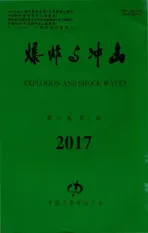方孔障碍物对瓦斯火焰传播影响的实验与大涡模拟*
2017-04-10李艳超黄福军张玉涛
陈 鹏,李艳超,黄福军,张玉涛
(1.中国矿业大学(北京)煤炭资源与安全开采国家重点实验室,北京100083;2.中国矿业大学(北京)资源与安全工程学院,北京100083)
方孔障碍物对瓦斯火焰传播影响的实验与大涡模拟*
陈 鹏1,2,李艳超2,黄福军2,张玉涛2
(1.中国矿业大学(北京)煤炭资源与安全开采国家重点实验室,北京100083;2.中国矿业大学(北京)资源与安全工程学院,北京100083)
为揭示置障管道内甲烷/空气预混火焰传播特性,运用高速摄影技术对甲烷/空气预混火焰的形状变化和火焰前锋的速度特性进行实验,并利用大涡模拟对管道内的流场结构进行数值分析。结果表明:置障管道内依次出现了球形火焰、指尖形火焰及“蘑菇”状火焰,且“蘑菇”状火焰出现之后,火焰开始反向传播;“蘑菇”状火焰是双涡旋结构与火焰前锋面相互作用的结果,而火焰的反向传播是由流场中出现逆流结构引起的;障碍物对火焰前锋有明显的加速作用;大涡模拟成功再现了实验中观察到的火焰形状、火焰前锋速度及流场结构,说明大涡模拟适用于置障管道内预混火焰传播特性的研究。
爆炸力学;火焰前锋;大涡模拟;高速摄影技术;甲烷/空气预混火焰;方孔障碍物
瓦斯爆炸是发生在煤矿井下最严重的灾害之一。在实际矿井巷道中不可避免地存在各种障碍物,如通风设备、支护设施及各种管道等,当火焰与障碍物相互作用时,火焰的形态、火焰传播速度、流场结构及爆炸压力等都会发生显著变化[1-4]。因此,研究火焰与障碍物的相互作用机制及由此引发的流场结构变化对于有效预防瓦斯爆炸事故的发生及降低灾害损失有着重大意义。
学者们对置障条件下的瓦斯爆炸机理、传播特性以及火焰和流场相互作用进行了深入研究[5-6]。A.R.Masri等[7]进行了障碍物孔型对火焰传播速度影响实验,指出与三角形和圆形障碍物相比,方形障碍物对火焰的加速作用更明显。R.Hall等[8]分析了障碍物数量对湍流预混火焰传播特性的影响,发现爆炸超压随障碍物数量的增加而增大,但存在上限,超过上限后,爆炸超压随障碍物数量的增加而减小。P.Chen等[9]通过改变障碍物阻塞比证明了火焰传播速度和压力增长速度随阻塞比的增大而增加,并指出火焰穿越障碍物后速度的改变是火焰和湍流相互作用的结果。障碍物能显著增强管道内流场的湍流强度,提高火焰燃烧效率[10]。C.T.Johansen等[11]利用新型的纹影技术捕捉到了障碍物后的涡旋结构,并指出火焰传播特性变化的根本原因在于火焰与涡旋的相互作用。V.D.Sarli等[12]利用粒子示踪技术得到了障碍物后的涡旋结构,实验证明了火焰与涡旋的相互作用是火焰加速及火焰形态变化的主要原因。实验手段很难得到气体爆燃过程中火焰和流场的精细结构,大涡模拟(large eddy simulation,LES)可以揭示火焰传播过程中的流动现象,有助于理解层流火焰向湍流火焰转变、燃烧不稳定性和火焰形态变化等[13]。本文中通过实验和大涡模拟对含障碍物管道内甲烷/空气预混火焰传播特性进行研究,研究置障管道内火焰传播的动力学特性,通过对比实验和模拟结果,验证大涡模拟的有效性。
1 实验系统
图1所示为甲烷/空气预混火焰传播实验系统示意图。该系统由定容燃烧管道、高速摄影系统、混气系统、高压点火系统和同步控制系统等组成。实验管道为一方形直管,长度为500mm,横断面尺寸为110mm×80mm。障碍物(厚度4mm)与点火点相距200mm,方孔截面积为50mm×50mm,障碍物的材质为阻燃有机玻璃板,实验前后,方孔玻璃板无结构损坏和形变,障碍物的上下端与固定在管道内的凹槽相连接。为提供高速摄影所需光路,管道前后两侧由石英玻璃板制成。实验中的点火器和高速摄像系统由同步控制器进行同步控制。高速摄像机的拍摄速度设置为960s-1。实验气体的甲烷的体积分数为7%,管道的初始温度和压力分别为298K和0.1MPa。可燃气被高能点火器点燃之前,静置60s,点火电极安装在管道左端的法兰上,高能点火器点火能可调范围是3~20J。

图1 实验系统示意图Fig.1 Sketch of experimental system
2 数学模型
2.1 控制方程
随着计算机性能的提高,计算流体力学在燃烧科学领域应用日益广泛[14-15]。本文中大涡模拟所采用的控制方程为滤波后的三维瞬态质量守恒方程、动量守恒方程、能量守恒方程和反应进程变量方程[3,16]。大涡模拟放弃对全尺度范围上涡结构瞬时运动的模拟,只将比网格尺度大的湍流运动通过瞬时N-S方程直接计算,而小尺度涡对大涡运动的影响则通过亚格子模型(sub-gridscale model)进行建模处理。其中,反应进程变量方程控制着甲烷/空气反应物的化学反应状态,通过控制反应进程变量捕捉火焰燃烧面,大涡模型的控制方程为[17]:

式中:LES滤波的参量标注为横线上标,质量权重滤波的参量标注为波浪线上标;ρ为密度,p为压力,ui、uj为速度分量,t为时间,应力张量σij由分子黏度μ决定,可表示为,τij为亚网格尺度应力,将其定义为为显焓,λ为热导率,亚网格热焓通量可通过梯度假设近似为:,其中:μSGS为亚网格黏度,PrSGS为亚网格的普朗特数,cp为定压比热,T为温度。
2.2 初始条件和边界条件
点火前,管道内甲烷/空气混合气保持静止,初温和初压分别为298K和0.1MPa。设反应过程变量c为量纲一化的产物质量分数,相应地,c=0对应为未燃反应物,c=1对应为已燃产物。将初始化学反应过程变量在整个流体区域设置为c=0,并通过将c设置为0.1来实现点火,点火半径为10mm。管道边界条件为无滑移、绝热边界条件。网格为结构网格,单元特征尺寸为2mm×2mm×2mm。应用ANSYS Fluent软件作为计算平台,压力速度耦合采用SIMPLE算法,对流项采用二阶逆风格式,扩散项采用中心差分格式。
3 结果与讨论
3.1 火焰前锋发展的高速摄影图片
图2所示为置障条件下甲烷/空气预混火焰传播的高速摄影图像。t=10ms时,由于未受到障碍物和管道侧壁影响,火焰阵面以球形向前传播;之后,管道侧壁开始阻碍火焰的自由发展,火焰形状由球形转变成指尖形,且火焰裙边在t=32ms时接触管道侧壁,火焰燃烧表面积开始减小;t=42ms时,障碍物开始作用于火焰前锋,平滑的弧面火焰前沿开始变尖;t=44ms时,火焰恰好穿过障碍物的方孔;t=48ms时,穿过方孔的火焰再次发生变形,并在t=50ms时形成“蘑菇”状的火焰前端;50ms之后“蘑菇”状火焰开始破碎,值得注意的是,“蘑菇”状靠近上下壁面的部分开始反向传播,并在t=53ms时反向穿过方孔结构。从火焰形态特征而言,置障条件下管道内的预混火焰经历了层流向湍流燃烧的转变。

图2 置障管道内甲烷/空气预混火焰传播的高速摄影图像Fig.2 Sequences of high-speed images of premixed methane/air flame propagating in an obstructed duct
3.2 火焰前锋发展的大涡模拟
图3所示为置障条件下甲烷/空气预混火焰传播的大涡模拟,其中燃烧面的反应进程变量c=0.1。

图3 甲烷/空气预混火焰传播的大涡模拟Fig.3 Large eddy simulation of premixed methane/air flame propagating in obstructed duct
从图3中可以发现,基于大涡模型的数值模拟成功再现了实验观察到的火焰形态及传播现象,如球形火焰、指尖形火焰、“蘑菇”状火焰及其反向流动等。这也证明了大涡模型对于模拟置障条件下甲烷/空气预混火焰传播的可行性。
3.3 流场结构
图4所示为置障条件下甲烷/空气预混火焰传播的流场结构。数值模拟中红色代表已燃气体,蓝色代表未燃气体,白色箭头线代表速度矢量。

图4 置障管道内甲烷/空气预混燃烧的流场结构Fig.4 Flow field of premixed methane/air flame propagating in an obstructed duct
在t=42ms之前,管道内的气体流动是层流状态,流线分布均匀无交叉;t=49ms时,未燃区域出现双涡旋结构,且涡旋范围不断扩大,涡旋中心逐渐向障碍物移动;t=50ms时,已燃区的流动方向由原来的正向流动反转成逆向;t=51ms时,未燃区域方孔障碍物附近也出现逆流。可以推断,“蘑菇”状火焰的形成与双涡旋结构密切相关,而燃烧后期的火焰反向传播是由流场的逆流结构造成的。
3.4 火焰前锋的动力学变化
图5所示为火焰前锋位置随时间的变化关系的数值模拟和实验结果。可见,t=42ms时刻是火焰前锋位置随着时间变化的转折点,在42ms之前,变化速率较为缓慢,在42ms之后,变化速率突然增大。图6所示为火焰前锋速度随时间的变化特性。从图6中可以看出,在32ms之前,火焰前锋速度随着燃烧表面积的增大而缓慢上升;当t=32ms时,火焰裙边触壁,燃烧表面积突然减小,进而引起火焰传播速度的小幅度减小;当t=44ms时,火焰前锋速度达到最大值17m/s,此时火焰前锋正在穿越障碍物的方孔。

图5 火焰前锋位置随时间的变化特性Fig.5 Histories of flame front surface position

图6 火焰前锋速度随时间的变化特性Fig.6 Histories of flame front surface velocity
4 结 论
本文中通过实验和数值模拟研究了方孔障碍物对管道内甲烷/空气预混火焰传播特性的影响。采用高速摄影技术揭示了火焰过程中的形状变化和火焰传播速度特性,并应用大涡模拟对火焰传播行为做了进一步分析。得到结论如下:
(1)由于未受到方孔障碍物的影响,前期火焰经历了球形火焰和指尖形火焰两个阶段,指形火焰触壁之前,火焰燃烧面积快速增大;触壁之后,火焰燃烧面积迅速减小。临近方孔时,平滑的弧面火焰前沿开始变尖,并且火焰前沿在穿过方孔障碍物后形成“蘑菇”状火焰;火焰前沿接近管道尾端时,“蘑菇”状火焰的靠近上下壁面的部分开始反向传播,并在t=53ms时反向穿过方孔结构。
(2)火焰前沿形状的变化与管道内的流场结构密切相关。通过分析流场结构可以发现,“蘑菇”状火焰的形成与双涡旋结构有直接联系,而燃烧后期的火焰反向传播是由流场中出现的逆流造成的。
(3)方孔障碍物对预混火焰的加速作用显著,火焰未穿过障碍物之前,火焰裙边触壁时刻,火焰传播速度达到5.72m/s;当火焰穿越方孔时,火焰传播速度再次达到最大值17m/s。
(4)大涡模拟成功再现了实验中观察到的火焰形状、火焰前锋速度及流场结构。说明大涡模拟对于模拟置障管道内甲烷/空气预混火焰传播的可行性。
[1]Dorofeev S B.Flame acceleration and explosion safety applications[J].Proceedings of the Combustion Institute,2011,33(2):2161-2175.
[2]Alharbi A,Masri A R,Ibrahim S S.Turbulent premixed flames of CNG,LPG,and H2propagating past repeated obstacles[J].Experimental Thermal and Fluid Science,2014,56(7):2-8.
[3]Johansen C T,Ciccarelli G.Modeling the initial flame acceleration in an obstructed channel using large eddy simulation[J].Journal of Loss Prevention in the Process Industries,2013,26(4):571-585.
[4]陈志华,叶经方,范宝春,等.方形管内楔形障碍物对火焰结构与传播的影响[J].爆炸与冲击,2006,26(3):208-213.Chen Zhihua,Ye Jingfang,Fan Baochun,et al.Effects of a wedge obstacle on flame propagation and its structure[J].Explosion and Shock Waves,2006,26(3):208-213.
[5]Ciccarelli G,Dorofeev S.Flame acceleration and transition to detonation in ducts[J].Progress in Energy &Combustion Science,2008,34(4):499-550.
[6]Kundu S,Zanganeh J,Moghtaderi B.A review on understanding explosions from methane-air mixture[J].Journal of Loss Prevention in the Process Industries,2016(40):507-523.
[7]Masri A R,Ibrahim S S,Nehzat N,et al.Experimental study of premixed flame propagation over various solid obstructions[J].Experimental Thermal and Fluid Science,2000,21(1/2/3):109-116.
[8]Hall R,Masri A R,Yaroshchyk P,et al.Effects of position and frequency of obstacles on turbulent premixed propagating flames[J].Combustion and Flame,2009,156(2):439-446.
[9]Chen P,Li Y C,Huang F J,et al.Experimental and LES investigation of premixed methane/air flame propagating in a chamber for three obstacle BR configurations[J].Journal of Loss Prevention in the Process Industries,2016,41(5):48-54.
[10]Wen X P,Yu M G,Liu Z C,et al.Large eddy simulation of methane-air deflagration in an obstructed chamber using different combustion models[J].Journal of Loss Prevention in the Process Industries,2012,25(25):730-738.
[11]Johansen C T,Ciccarelli G.Visualization of the unburned gas flow field ahead of an accelerating flame in an obstructed square channel[J].Combustion and Flame,2009,156(2):405-416.
[12]Sarli V D,Benedetto A D,Russo G,et al.Large eddy simulation and PIV measurements of unsteady flames accel-erated by obstacles[J].Flow Turbulence and Combustion,2009,83(2):227-250.
[13]Sarli V D,Benedetto A D,Russo G.Sub-grid scale combustion models for large eddy simulation of unsteady premixed flame propagation around obstacles[J].Journal of Hazardous Materials,2010,180(1/2/3):71-78.
[14]Ibrahim S S,Gubba S R,Malalasekera W,et al.Calculations of explosion deflagration flames using a dynamic flame surface density model[J].Combustion,Explosion,and Shock Waves,2012,48(4):393-405.
[15]马秋菊,张奇,庞磊.巷道壁面与瓦斯爆炸相互作用的数值模拟[J].爆炸与冲击,2014,34(1):23-27.Ma Qiuju,Zhang Qi,Pang Lei.Numerical simulation on interaction between laneway surface and methane explosion[J].Explosion and Shock Waves,2014,34(1):23-27.
[16]Gubba S R,Ibrahim S S,Malalasekera W,et al.Measurements and LES calculations of turbulent premixed flame propagation past repeated obstacles[J].Combustion and Flame,2011,158(12):2465-2481.
[17]Zimont V L,Battaglia V.Joint RANS/LES approach to premixed flame modelling in the context of the TFC combustion model[J].Flow Turbulence and Combustion,2006,77(1):305-331.
LES approach to premixed methane/air flame propagating in the closed duct with a square-hole obstacle
Chen Peng1,2,Li Yanchao2,Huang Fujun2,Zhang Yutao2
(1.State Key Laboratory of Coal Resources and Safety Mining,China University of Mining &Technology,Beijing100083,China;2.School of Resource and Safety Engineering,China University of Mining &Technology,Beijing100083,China)
Aiming at revealing the characteristics of premixed methane/air flame propagating in an obstructed duct.A 4mm thick obstacle with a square hole of 50mm×50mm was equipped at 210mm from the ignition source.In the experiment,the high-speed video photography was used to study the flame shape changes and flame front speed.In the numerical simulation,the large eddy simulation(LES)was applied to investigating the flow structure.The results demonstrate that the flame-tip successively takes on a spherical,finger and mushroom-like shape,and the flame begins to propagate in the backward direction after the mushroom-like flame appears.The mushroom-like flame can be explained by the interaction of the flame with two vortexes,and the reverse flow emerged in the flow field leads to the backward motion of the premixed flame.The flame speed is accelerated significantly due to the obstacle and the flame tip speed reaches the maximum value of 17m/s when the flame passes through the square hole of the obstacle.The flame shape changes and the flow structure observed in the experiments can be well reproduced in the numerical simulations using the LES model.It is indicated that the LES model can be used to predict the premixed flame propagating in an obstructed duct.
mechanics of explosion;flame front surface;large eddy simulation;high-speed video photography;premixed methane/air flame;square-hole obstacle
O381;TD712国标学科代码:13035
A
10.11883/1001-1455(2017)01-0021-06
(责任编辑 王易难)
2015-05-20;
2015-08-25
国家自然科学基金项目(51274205);煤炭资源与安全开采国家重点实验室开放课题项目(SKLCRSM10KFB13)
陈 鹏(1971— ),男,博士,副教授,chenpeng@cumtb.edu.cn。
